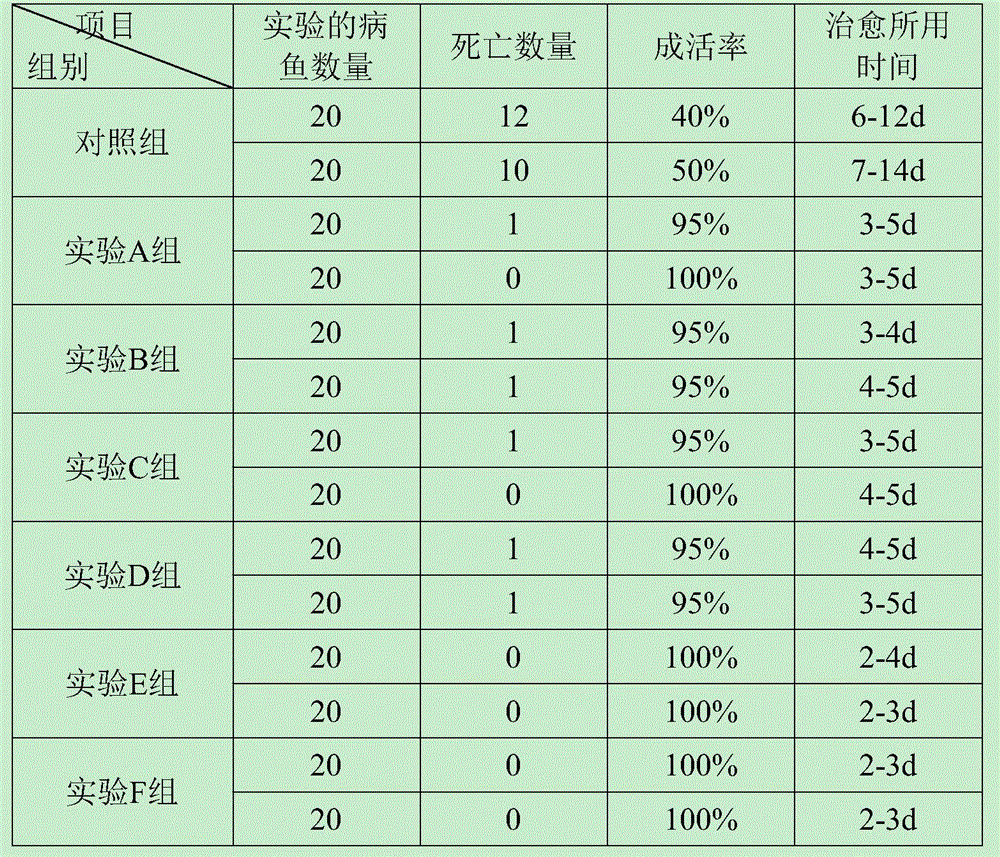Tincture for treating turbot fin rot and preparation method thereof
A technology of fin rot and tincture of turbot, applied in the field of aquaculture, can solve the problems of easy pollution of the environment, high toxicity, and affecting people's health, and achieve the goal of small damage, rapid health recovery, and conducive to healthy and sustainable development Effect
- Summary
- Abstract
- Description
- Claims
- Application Information
AI Technical Summary
Problems solved by technology
Method used
Image
Examples
Embodiment 1
[0033] A tincture for treating turbot fin rot disease, which is composed of the following components in parts by mass: 40 parts of duckweed, 33 parts of Vitex bark, 33 parts of Houttuynia cordata, 32 parts of Lycoris, 32 parts of Fructus Cnidii, 28 parts of Prunella vulgaris, 30 parts of milk vetch, 16 parts of honeycomb, 29 parts of melon stalks, 27 parts of grape seeds, 25 parts of ephedra, 24 parts of Asarum, 23 parts of Baiyaozi, 23 parts of Fangfeng, 22 parts of Radix Peucedanum, Scutellaria baicalensis 20 parts, 20 parts of acacia, 18 parts of acacia, 18 parts of dandelion, 16 parts of Malan, 16 parts of peppermint oil, 14 parts of white vinegar, 10 parts of honey, 6 parts of hyaluronic acid, 7 parts of sheep's whiskers, 9 parts of sumac, quality 25 parts of 75% alcohol.
[0034] The preparation method of the above-mentioned tincture for the treatment of turbot fin rot disease comprises the following steps:
[0035] (1) Weigh duckweed and dandelion according to the prop...
Embodiment 2
[0043] A tincture for treating turbot fin rot disease, which is composed of the following components in parts by mass: 42 parts of duckweed, 32 parts of Vitex bark, 32 parts of Houttuynia cordata, 32 parts of Lycoris, 32 parts of Fructus Cnidii, 30 parts of Prunella vulgaris, 28 parts of milk vetch, 14 parts of honeycomb, 28 parts of melon stalks, 26 parts of grape seeds, 25 parts of ephedra, 24 parts of Asarum, 24 parts of Baiyaozi, 22 parts of Fangfeng, 21 parts of Radix Peucedanum, Scutellaria baicalensis 22 parts, 18 parts of acacia, 17 parts of acacia, 17 parts of dandelion, 18 parts of Malan, 15 parts of peppermint oil, 16 parts of white vinegar, 9 parts of honey, 5 parts of hyaluronic acid, 6 parts of sheep's whiskers, 10 parts of sumac, quality Concentration is 75% alcohol 28 parts.
[0044] The preparation method of the tincture for the treatment of turbot fin rot disease of the present embodiment is the same as that in Example 1.
Embodiment 3
[0046] A tincture for treating turbot fin rot disease, which consists of the following components in parts by mass: 35 parts of duckweed, 28 parts of Vitex bark, 27 parts of Houttuynia cordata, 26 parts of Lycoris, 26 parts of Cnidium, 24 parts of Prunella vulgaris, 23 parts of milk vetch, 10 parts of honeycomb, 24 parts of melon stalks, 19 parts of grape seeds, 18 parts of ephedra, 18 parts of Asarum, 18 parts of Baiyaozi, 16 parts of Fangfeng, 15 parts of Radix Peucedanum, Scutellaria baicalensis 15 parts, 14 parts of acacia, 14 parts of acacia, 12 parts of dandelion, 10 parts of Malan, 9 parts of peppermint oil, 7 parts of white vinegar, 5 parts of honey, 3 parts of hyaluronic acid, 6 parts of sheep's whiskers, 6 parts of sumac, quality Concentration is 20 parts of 75% alcohol.
[0047] The preparation method of the tincture for the treatment of turbot fin rot disease of the present embodiment is the same as that in Example 1.
PUM
 Login to View More
Login to View More Abstract
Description
Claims
Application Information
 Login to View More
Login to View More - R&D
- Intellectual Property
- Life Sciences
- Materials
- Tech Scout
- Unparalleled Data Quality
- Higher Quality Content
- 60% Fewer Hallucinations
Browse by: Latest US Patents, China's latest patents, Technical Efficacy Thesaurus, Application Domain, Technology Topic, Popular Technical Reports.
© 2025 PatSnap. All rights reserved.Legal|Privacy policy|Modern Slavery Act Transparency Statement|Sitemap|About US| Contact US: help@patsnap.com


